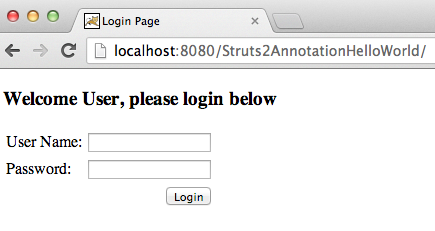这是Struts 2教程系列中的第二篇文章。如果你直接来到这里,我建议你也查看之前的帖子。Struts 2初学者教程在上一篇教程中,我们了解了Struts 2的架构,它的组件,并使用基于XML的配置(struts.xml)构建了一个简单的Struts 2 Web应用程序。在本教程中,我们将看到如何完全使用注解或命名约定来避免Struts配置文件。
Struts 2约定概念
Struts 2使用两种方法来查找操作类和结果类。我们需要使用struts2-convention-plugin API来使用其中任何一种方法。如果你有一个普通的Web应用程序,你可以下载它的jar文件并将其放在Web应用程序lib目录中。对于Maven项目,你可以像下面这样简单地添加它的依赖。
<dependency>
<groupId>org.apache.struts</groupId>
<artifactId>struts2-convention-plugin</artifactId>
<version>2.3.15.1</version>
</dependency>
-
扫描:在这种方法中,我们指定需要扫描以查找操作类的包。配置需要在web.xml中为Struts 2过滤器完成,如下所示。
<filter> <filter-name>struts2</filter-name> <filter-class>org.apache.struts2.dispatcher.ng.filter.StrutsPrepareAndExecuteFilter</filter-class> <init-param> <param-name>actionPackages</param-name> <param-value>com.journaldev.struts2.actions</param-value> </init-param> </filter>Struts 2将通过以下方法查找操作类。
-
命名约定: Struts 2将自动为类名以Action结尾的类创建动作。动作名称由去除Action后缀并将第一个字母转换为小写来确定。因此,如果类名为HomeAction,则动作将是“home”。如果这些类没有用@Result进行注解以提供结果,那么结果页面将在WEB-INF/content目录中查找,名称应为{action}-{return_string}.jsp。因此,如果HomeAction动作类返回“success”,则请求将转发到WEB-INF/content/home-success.jsp页面。仅使用命名约定可能会很令人困惑,我们不能在其他动作类中使用相同的JSP页面。因此,我们应该尽量避免这种情况,而是使用基于注解的配置。
现在我们准备使用注释来创建我们的Hello World Struts 2应用程序,并且我们将不使用Struts 2配置文件。在Eclipse Struts2AnnotationHelloWorld中创建一个动态Web项目,并将其转换为Maven项目。最终项目如下图所示。
Maven配置
我们在pom.xml中添加了struts2-core和struts2-convention-plugin的依赖项,最终的pom.xml代码如下:
<project xmlns="https://maven.apache.org/POM/4.0.0" xmlns:xsi="https://www.w3.org/2001/XMLSchema-instance"
xsi:schemaLocation="https://maven.apache.org/POM/4.0.0 https://maven.apache.org/xsd/maven-4.0.0.xsd">
<modelVersion>4.0.0</modelVersion>
<groupId>Struts2AnnotationHelloWorld</groupId>
<artifactId>Struts2AnnotationHelloWorld</artifactId>
<version>0.0.1-SNAPSHOT</version>
<packaging>war</packaging>
<dependencies>
<dependency>
<groupId>org.apache.struts</groupId>
<artifactId>struts2-core</artifactId>
<version>2.3.15.1</version>
</dependency>
<dependency>
<groupId>org.apache.struts</groupId>
<artifactId>struts2-convention-plugin</artifactId>
<version>2.3.15.1</version>
</dependency>
</dependencies>
<build>
<plugins>
<plugin>
<artifactId>maven-compiler-plugin</artifactId>
<version>3.1</version>
<configuration>
<source>1.6</source>
<target>1.6</target>
</configuration>
</plugin>
<plugin>
<artifactId>maven-war-plugin</artifactId>
<version>2.3</version>
<configuration>
<warSourceDirectory>WebContent</warSourceDirectory>
<failOnMissingWebXml>false</failOnMissingWebXml>
</configuration>
</plugin>
</plugins>
<finalName>${project.artifactId}</finalName>
</build>
</project>
部署描述符配置
<?xml version="1.0" encoding="UTF-8"?>
<web-app xmlns:xsi="https://www.w3.org/2001/XMLSchema-instance"
xmlns="https://java.sun.com/xml/ns/javaee"
xsi:schemaLocation="https://java.sun.com/xml/ns/javaee https://java.sun.com/xml/ns/javaee/web-app_3_0.xsd"
id="WebApp_ID" version="3.0">
<display-name>Struts2AnnotationHelloWorld</display-name>
<filter>
<filter-name>struts2</filter-name>
<filter-class>org.apache.struts2.dispatcher.ng.filter.StrutsPrepareAndExecuteFilter</filter-class>
<init-param>
<param-name>actionPackages</param-name>
<param-value>com.journaldev.struts2.actions</param-value>
</init-param>
</filter>
<filter-mapping>
<filter-name>struts2</filter-name>
<url-pattern>/*</url-pattern>
</filter-mapping>
</web-app>
请注意init-param元素,我们在其中提供将由Struts 2扫描的动作类包。
结果页面
我们的应用程序中有三个结果页面。login.jsp
<%@ page language="java" contentType="text/html; charset=US-ASCII"
pageEncoding="US-ASCII"%>
<!DOCTYPE html PUBLIC "-//W3C//DTD HTML 4.01 Transitional//EN" "https://www.w3.org/TR/html4/loose.dtd">
<%-- Using Struts2 Tags in JSP --%>
<%@ taglib uri="/struts-tags" prefix="s"%>
<html>
<head>
<meta http-equiv="Content-Type" content="text/html; charset=US-ASCII">
<title>Login Page</title>
</head>
<body>
<h3>Welcome User, please login below</h3>
<s:form action="login">
<s:textfield name="name" label="User Name"></s:textfield>
<s:textfield name="pwd" label="Password" type="password"></s:textfield>
<s:submit value="Login"></s:submit>
</s:form>
</body>
</html>
error.jsp
<%@ page language="java" contentType="text/html; charset=US-ASCII"
pageEncoding="US-ASCII"%>
<%@ taglib uri="/struts-tags" prefix="s"%>
<!DOCTYPE html PUBLIC "-//W3C//DTD HTML 4.01 Transitional//EN" "https://www.w3.org/TR/html4/loose.dtd">
<html>
<head>
<meta http-equiv="Content-Type" content="text/html; charset=US-ASCII">
<title>Error Page</title>
</head>
<body>
<h4>User Name or Password is wrong</h4>
<s:include value="login.jsp"></s:include>
</body>
</html>
welcome.jsp
<%@ page language="java" contentType="text/html; charset=US-ASCII"
pageEncoding="US-ASCII"%>
<%@ taglib uri="/struts-tags" prefix="s"%>
<!DOCTYPE html PUBLIC "-//W3C//DTD HTML 4.01 Transitional//EN" "https://www.w3.org/TR/html4/loose.dtd">
<html>
<head>
<meta http-equiv="Content-Type" content="text/html; charset=US-ASCII">
<title>Welcome Page</title>
</head>
<body>
<h3>Welcome <s:property value="name"></s:property></h3>
</body>
</html>
现在让我们创建我们的Action类,我们将用注解配置动作和结果页面。
带注解的Action类
package com.journaldev.struts2.actions;
import org.apache.struts2.convention.annotation.Action;
import org.apache.struts2.convention.annotation.Actions;
import org.apache.struts2.convention.annotation.Namespace;
import org.apache.struts2.convention.annotation.Namespaces;
import org.apache.struts2.convention.annotation.Result;
import com.opensymphony.xwork2.ActionSupport;
/**
* An empty class for default Action implementation for:
*
* <action name="home">
* <result>/login.jsp</result>
* </action>
* HomeAction class will be automatically mapped for home.action
* Default page is login.jsp which will be served to client
* @author pankaj
*
*/
@Namespaces(value={@Namespace("/User"),@Namespace("/")})
@Result(location="/login.jsp")
@Actions(value={@Action(""),@Action("home")})
public class HomeAction extends ActionSupport {
}
请注意,HomeAction是一个空类,只用于将请求转发到login.jsp页面。
package com.journaldev.struts2.actions;
import org.apache.struts2.convention.annotation.Action;
import org.apache.struts2.convention.annotation.Namespace;
import org.apache.struts2.convention.annotation.Namespaces;
import org.apache.struts2.convention.annotation.Result;
/**
* Notice the @Action annotation where action and result pages are declared
* Also notice that we don't need to implement Action interface or extend ActionSupport
* class, only we need is an execute() method with same signature
* @author pankaj
*
*/
@Action(value = "login", results = {
@Result(name = "SUCCESS", location = "/welcome.jsp"),
@Result(name = "ERROR", location = "/error.jsp") })
@Namespaces(value={@Namespace("/User"),@Namespace("/")})
public class LoginAction {
public String execute() throws Exception {
if("pankaj".equals(getName()) && "admin".equals(getPwd()))
return "SUCCESS";
else return "ERROR";
}
//用于保存表单参数的Java Bean
private String name;
private String pwd;
public String getName() {
return name;
}
public void setName(String name) {
this.name = name;
}
public String getPwd() {
return pwd;
}
public void setPwd(String pwd) {
this.pwd = pwd;
}
}
请注意使用了@Action,@Actions,@Result,@Namespace和@Namespaces注解,用法是不言自明的。现在运行我们的应用程序时,我们会得到以下响应页面。

 如果您已阅读了上一篇文章,在那里我们使用了struts.xml配置开发了相同的应用程序,您会注意到它几乎相同。唯一的变化是我们如何连接我们的应用程序动作类和结果页面。
如果您已阅读了上一篇文章,在那里我们使用了struts.xml配置开发了相同的应用程序,您会注意到它几乎相同。唯一的变化是我们如何连接我们的应用程序动作类和结果页面。













